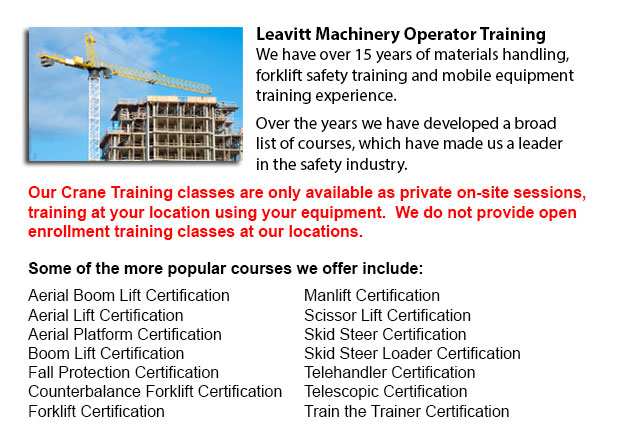
Richmond Hill Crane Certification - The Crane Certification Program consists of the industry recommended content that would teach the safe and efficient operation of cranes. The person will train in the following: pre-operational, operational and post operating requirements; how to identify cranes and their component parts; how to determine overall lift capacity; rigging components and inspection/rejection criteria; and requirements specific to the work site where the individuals training will be operating.
The requirements that have to be done before operating a crane such as assigning authority for the pre-operational check; performing the sequential pre-operational check based on the manufacturer's specifications or specifications certified by a professional engineer; checking the log book for comments; checking the work place for hazards and obstacles; checking hooks, chains, cables, crane movement and safety latches; making certain of the correct functioning of operational controls; and knowing how to ensure the disconnect switch/isolator of the crane is working properly.
Operational requirements comprise identifying responsibilities and roles, and determining the requirement for a formal lift plan. Trainees will know how to perform a danger assessment associated to environmental circumstances, physical circumstances and workers. Subject matter consists of determining when to seek competent aid, the destination of loads and the safest route, and centre of gravity and load weight.
Individuals training should be able to identify an over-capacity lift, in addition to be able to select right rigging machinery, select load limitations, and to determine the safe position for the crane to operate from. Trainees would review both site-specific and universal crane signals for lifts, and methods for lifting, loading and traveling. Proper maintenance practice would also be included.
The person training will undergo an examination to test their understanding of emergency response procedures for various conditions, specifically mechanical or electrical failures. They will be asked to describe shut down and parking procedures for security and safety, to follow tagging and lock out techniques, and to explain why near misses are recorded and reported to the right person. Log book records have to be maintained.
The person training will be taught the particulars of rigging, and know the responsibility and authority for rigging. They will know to identify the various types of rigging, the load capacity ratings and storage procedures.
The requirements after operation of the crane would be taught as well, learning to enter the deficiencies and defects; and to log the history of service and maintenance records, in accordance to the federal, state and provincial codes requirements.
Site-specific needs could be incorporated into the safety training program based on the employer's needs.
-
Richmond Hill Manlift Operator Training
Richmond Hill Manlift Operator Training - The aerial lift or manlift is a specialized type of hydraulic platform that is meant to lift an individual vertically giving it an alternate name of a vertical personnel lift. These machines are widely used f... More -
Richmond Hill Boom Lift Training
Richmond Hill Boom Lift Training - Aerial platforms or likewise known as elevated work platforms are devices that enable workers to perform tasks and duties at elevated heights which would not be otherwise accessible. There are a variety of aerial li... More -
Richmond Hill Overhead Crane Safety Training
Richmond Hill Overhead Crane Safety Training - Overhead crane safety training equips operators with knowledge and skills about crane safety measures, accident avoidance, materials handling, and machinery and stock protection. Trainees will learn the... More -
Richmond Hill Heavy Equipment License
Richmond Hill Heavy Equipment License - A heavy equipment license could be acquired by taking a certification and preparation course at a private training school or a vocational school. This license would qualify you to operate many kinds of heavy ma... More -
Richmond Hill Manlift Training
Richmond Hill Manlift Training - Various manlift training programs consist of the review and content of manlift devices. An important part of the program is the practicum where students show their knowledge and practical ability to safely operate a m... More -
Aerial Lift / Boom Lift / Man Lift / Scissor Lift Training in Richmond Hill
Scissor platform lifts are forklift tables that elevate things and individuals and goods vertically. They are often used in industrial, construction and commercial environments. A common use of scissor platform lifts is for lowering or lifting constr... More -
Richmond Hill Scissor Lift Safety Training
Richmond Hill Scissor Lift Safety Training - A scissor lift is a kind of platform lift that moves vertically. The lift table is moved in a vertical motion because of criss-cross folding supports which are linked in what is known as a pantograph. The... More -
Richmond Hill Heavy Equipment Training
Richmond Hill Heavy Equipment Training - The two most common types of heavy equipment training are classed into the categories of equipment; machines which is fashioned with tracks and those with rubber tires. The tracked vehicle are heavy duty machi... More

Forklift Certification Richmond Hill
TOLL FREE: 1-888-254-6157
Richmond Hill, Ontario
forkliftcertificationrichmondhill.com
Email Us
About Us


